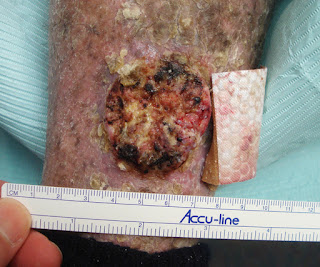HPI: The patient is a 69 yo man with a greater than 40 year history of severe psoriasis. He was a research subject at a prestigious university hospital for many years. Over that time, he has received PUVA, methotrexate and an investigational drug, Rapamycin. He has been treated with NB UVB and acitretin with some improvement. As a result of his therapies, he has developed numerous squamous cell carcinomas. These pose therapeutic challenges They are painful, foul smelling and difficult for the patient to care for. An additional problem is occasionally disabling trigeminal neuralgia. He has had many well-differentiated SCCs excised over the past decade. He has atrial fibrillation, Factor 5 deficiency and is on warfarin and a host of cardiac medication.
O/E: Wide-spread erythema and scale covering entire integument except head and neck. There is a 3 cm exophytic tumor of the left pre-tibial area and smaller similar tumors on right leg, back and chest.
Clinical Photos (6.6.17)
 |
| L. Pretibial |
Questions: Should these lesions be excised? Should we consider one of the new targeted therapies? Do any of our members have expertise with them? This man has a number of co-morbidities which may make therapy more difficult.
References:
Oral therapy for nonmelanoma skin cancer in
patients with advanced disease and large tumor burden: a review of the
literature with focus on a new generation of targeted therapies.
Rudnick EW, Thareja S, Cherpelis B. Int J
Dermatol. 2016 Mar;55(3):249-58
Author information
Abstract: This review of the literature
aims to describe previous and current treatment options for oral therapy in
locally advanced and metastatic NMSC otherwise unamenable to standard
treatment. Oral Smoothened (Smo) inhibitors Vismodegib, Sonidegib, and
Taladegib have shown to be effective in several trials. Oral tyrosine kinase
inhibitors Erlotinib and Gefitinib, which target epidermal growth factor
receptor (EGFR), have early supporting data and are currently undergoing large
multicenter trials. Oral therapy in NMSC is useful in high risk patients with
recurrent and aggressive disease who may not tolerate other systemic therapies.


Khalifa Sharquie from Baghdad writes: "I published many studies using topical podophyllin,topical zinc sulfate and Loranthus europieus in effective treatment of basal cell carcinoma ,solar keratosis and keratoacanthoma .These new therapies could applied in this elderly patient with many skin malignancy .The references will be sent soon. [I will post these for those who are interested.]
ReplyDeletefrom Patrick Kenny, Victoria, BC, Canada: I wondered if could be eruptive KAs. These Seem to respond to oral acitretin 25 mg daily and topical Imiquimod 5% cream 5 nights per week .
ReplyDeleteThanks, Pat. He has been on acitretin -- but 25 mg t.i.w. Your suggestions are helpful.
DeleteI suggest intralesional 5-fluorouracil. I use 1 mL of 5-FU 10 mg/mL mixed with 0.5 mL of 1% lidocaine with epinephrine. For the 3 cm tumor I would give a double dose, then repeat monthly until tumor resolves. If unimproved after 2-3 months, then I might consider radiation.
ReplyDeleteSteve Higgins
I have experience with multiple successive SCC appearing
ReplyDeletein a renal transplant patient.
Simple excisions without the need of wide excision for each occasion solve the problem with minimal cost and side effects. An already unhealthy skin should not be exposed to radiation and immunosuppressive as far as possible. If the lesion is too big for dermatologist like me, it will be time to renew bonding with our old friends like general surgeons or plastic surgeons, the choice depends on patient's preference including his financial consideration.
Thank you. Dr Cheng-Leng Ong
I use intralesional 5FU for patients with SCCs who cannot tolerate surgery and have had good success. I doubt it would work for the very large lesion pictured above, however. I wonder if radiation oncology might have some ideas for that one?
ReplyDeleteI think you could shave and debulk some of the scc and then inject intralesional methotrexate. You can use much lower doses than is published in the literature. Also is he able to do a dilute bleach bath to help with odor and secondary staph and candida?
ReplyDeleteI would suggest that this patient be seen and managed at an academic, if possible. That way he could be considered for targeted immunotherapeutic agents. At the AAD this year, there was mentioned an ongoing multicentric trial of a EGFR inhibitor (REGN 2810) that has shown promise for unresectable SCC. In a large center, he is likely to have access to clinical trials and drugs that may not be available elsewhere. A team approach would also increase the likelihood that his docs would have experience with some of the newer drugs in this rapidly changing field.
ReplyDeleteDear Dr Elpern , sorry for the late comment on this case , I would suggest that radiotherapy in the form of both field and localised treatment would be appropriate ,The new machines are much more accurate in defining depth penetration and with multiple fractionation of the doses the risk of collateral damage to the normal skin is minimised . With kind regards Dr Chris Tyson .
ReplyDelete